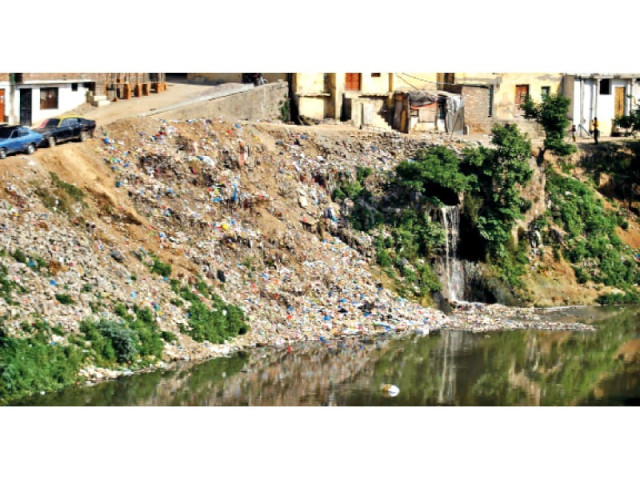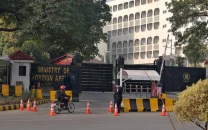In the mire: Murky waters of Nullah Leh threaten residents’ health and homes
Clogged with garbage, channel floods its banks in case of heavy rains.

A view of Nullah Leh that snakes down the town. PHOTO: MUHAMMAD JAVAID/ EXPRESS
Dumping solid waste in Nullah Leh and its tributaries continues and with predictions of a prolonged spell of rains in May, the town’s municipal agency has very little time to deal with the problem. But even civic officials may not realise that there might be a permanent solution.
People living on the banks of Nullah Leh, who spoke to The Express Tribune, appear to be aware of the threat all the garbage in and along the channel poses to their health and their homes. All they ask for are dumpsters so they can throw trash inside, instead of littering Nullah Leh.
In stark contrast to the banners installed on the stream’s banks, which urge residents to refrain from dumping waste in the channel, piles of garbage dot its path and hinder the flow of water. When residents of nearby areas were questioned about this, they complained that the only choice they were left with was to dispose off household waste in the nullah.
“Why would we dump waste here if dumpsters were placed outside our houses?” asked Muhammad Abbas, a resident of Nadeem Colony. We’re aware of the environmental consequences, he added, and ready to cooperate with civic officials, but they need to provide us with dumpsters first.
Heaps of plastic bags and household waste thrown into the stream not only hinder the water flow, but also contribute to the flooding of low-lying localities during heavy rains. Debris from various areas in the city is also dumped into the nullah.
“This year, more rains are predicted, but dredging has still not been carried out,” said a Rawal Town administration official. Unfortunately, the situation is no different for the 11 tributaries and 254 drains flowing into Nullah Leh.
“The nauseating smell emanating from the nullah has made it difficult for us to breathe and the clogged channel has become a breeding place for mosquitoes. The water and sanitation department should clear it twice a year,” said Attaullah, a resident of Katarian Pul.
Even residents of cantonment boards living by the Leh or its tributaries have converted the banks into dumping sites. Interestingly, however, officials claim the Leh and its tributaries do not flow through areas under their jurisdiction.
Although Wasa installed banners to create awareness about the implications of improper waste disposal and warned of strict action in case of failure to adhere to the warning, these steps have not helped.
“Until the district government provides dumpsters and ensures systematic disposal, residents of nearby localities will continue this practice,” commented Sajid Zaheer, a retired teacher and resident of Katarian Bridge.
The residents demanded immediate dredging of the nullah and its tributaries before the arrival of monsoon rains, to protect their homes from flooding.
A senior official of the Rawalpindi Waste Management Company (RWMC), requesting anonymity, said tributaries of the Nullah Leh were handed over to Town Municipal Administration (TMA) Rawal Town last year and the civic agency was responsible for Leh. But since TMA does not have the the requisite machinery, the district government assigned us the task of dredging the tributaries, he added.
“Although we’re also facing a shortage of machinery, we accepted the task after the district government requested us to take over for a year,” the official said. He added that next year, the town administration would take over as neither the main nullah nor its tributaries are included in RWMC’s agreement. Queries directed to Rawalpindi District Coordination Officer Sajid Zafar Dall went unanswered.
Published in The Express Tribune, April 26th, 2014.



















COMMENTS
Comments are moderated and generally will be posted if they are on-topic and not abusive.
For more information, please see our Comments FAQ